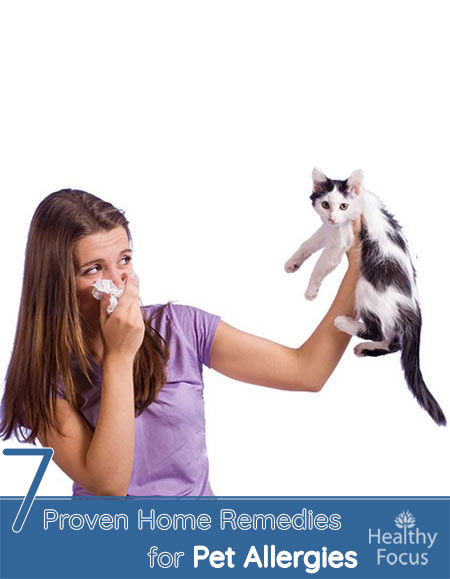Last Updated on November 25, 2019 by Marc Seward
Pet Allergies
You love your dogs and your cats, so do your children but unfortunately many of you may suffer an allergy to them. I suppose many people would recommend getting rid of your pet but that is so much easier said than done. I speak as someone who currently has 3 dogs and a cat, in fact I have always had a pet as long as I can remember and have always viewed them as members of the family.
Of course, if you or your child is suffering from an extreme allergic reaction, there may be little option but to find a new home for your precious pets but for many of us that would be a last resort and there are a variety of preventive and treatment possibilities that many of us would prefer to try first.
What causes Pet Allergies?
One of the biggest misunderstandings regarding pet allergies is that they are caused by the animal’s fur. I’m sure that you have heard at some point that long haired pets are more likely to cause an allergic reaction than a short haired dog or cat. Experts say that this is not true and that even two pets from the same breed might cause very different levels of allergy.
Your pet’s fur is actually not the biggest problem when it comes to allergens, rather it is dog or cat dander which causes the real issue. Pet dander is comprised of tiny particles of dead flaked skin and also urine and saliva. All pets give off a certain amount of dander regardless of their breed or length of fur.
Symptoms of Allergies
People who are prone to pet and other allergies have an overly sensitive immune system. Essentially their bodies are prone to overreacting when they come into contact with substances that are otherwise harmless like pet dander and pollen.
The immune system attacks responds by attacking the allergen in the same way that it attacks pathogenic bacteria and viruses. The common symptoms such as sneezing and red, watery eyes are simply a side effect of your body’s attempts to get rid of the allergen.
Symptoms of Pet Allergies
Symptoms of pet allergies are very similar to other types of allergy. They can cause a variety of symptoms due to inflammation of the nasal passages and also cause a skin reaction.
Symptoms include:
• Sneezing
• Runny nose
• Watery eyes
• Congestion
• Coughing
• Swelling under the eyes
• Difficulty breathing especially when the allergy is linked to asthma
• Itchy skin
• Eczema
• Hives
Differences between Dog and Cat Allergies
While some 10% of the population has a pet allergy, you are twice as likely to be allergic to a cat as a dog. Estimates suggest that around 1 in every 7 children are allergic to cats. The reason that cat allergies are significantly more common is related to the size and the shape of feline protein molecules and not the amount of dander that they shed.
Cat allergens are also considerably smaller than dog allergens and are able to remain airborne for longer. According to experts, the size of a cat allergen particle is perfect to breathe into your lungs. The allergenic cat protein known as Fel d 1 is also extremely sticky and easily attaches itself to upholstery, clothing and skin. It is fairly ubiquitous in houses that own a pet cat but has even been found in places that have no cats at all.
Prevention of Pet Allergies
Before we look at some possible natural remedies, it is important to note that you can do a few things to reduce your risk of exposure to pet allergens.
• Clean well: clean the floors, curtains and furniture as thoroughly as you can.
• Make dusting and cleaning easier: Consider replacing your carpet with tiling and reduce clutter from areas that dander may cling to.
• Filter your air
• Keep your pets out of the home if possible but make sure you don’t allow them into the family bedrooms.
Home Remedies for Pet Allergies
Conventional treatment usually involves antihistamine medication which reduces the reaction to allergic triggers. Unfortunately, antihistamines do not always work and they can cause severe drowsiness. Allergy shots are another possibility but a full course of treatment can take many years and success is not guaranteed. As a result, many people look for more natural remedies to treat their allergic reactions.
1. Nasal irrigation
Irrigating your nasal passage with saline water can be an effective and simple home remedy for allergic symptoms. It can help flush the sinuses and clear away irritations caused by allergens helping you to breathe more comfortably.
Many people use a neti pot for this purpose; neti pots are cheap and available at most pharmacies and are also useful for any type of sinus or nasal congestion. Nasal irrigation is even sometimes recommended by conventional doctors to help ease allergic symptoms.
You can either use a ready-made saline solution or make up your own. Simply dissolve a teaspoon of sea salt in a cup of pre-boiled distilled water, allow it to cool and add it to your neti pot. Tilt our head upwards and pour it into one nostril then let it drain from the other nostril and repeat on the opposite side.
2. Butterbur
If you suffer from pet allergies, then consider taking butterbur which many people use to ease their allergic symptoms. Butterbur is a natural alternative to pharmaceutical antihistamines which does no cause the same drowsiness.
It is derived from a common European weed and studies have shown that it is just as effective as cetirizine which is the main active ingredient found in the commonly prescribed antihistamine drug-Zyrtec.
A Swiss study demonstrated that while Zyrtec caused drowsiness, butterbur did not have the same sedative effect. Participants in the Swiss study took 32 mgs of butterbur each day divided into 4 equal doses. (1)
However, like many herbal remedies, you need to exercise caution and there is no evidence regarding the long term effects of taking butterbur. Make sure to get a PA-free butterbur extract like Petadolex.
Here (link) you can read a much more detailed review of butterbur for allergies and other ailments.
3. Essential oils
Many essential oil have natural antihistamine properties making them a safe and effective treatment for pet and other allergies without the risk of drowsiness. The best essential oils for allergies are lavender, lemon and peppermint but many others can also provide excellent relief including eucalyptus, lemongrass and helichrysum.
To use essential oils to ease your allergic symptoms, you can diffuse them in the home, inhale them directly from the bottle or make a steam inhaler by adding a few drops into a sink full of boiling water and inhaling the vapors. Alternatively, you can dilute your chosen essential oil in a carrier oil and dab it under your nostrils and temples.
Read this article (link) for a very thorough review regarding essential oils for allergies.
4. Stinging Nettle Leaf
Like butterbur, nettle leaf is a natural antihistamine which many people find extremely useful for treating pet allergies because it effectively blocks the body’s production of histamines. Nettles grow pretty much everywhere and you can easily make your own nettle tea however when it comes to allergies, capsules made with dry nettle leaves are thought to be more effective.
Experts suggest that around 300 mgs a day provide the best allergy relief. Like butterbur, stinging nettle does not cause the drowsiness associated with conventional antihistamines.
5. Probiotics
Allergic reactions are usually caused by an overreaction of the immune system when it is exposed to stimuli such as pet dander. Recent research has linked increased levels of beneficial gut bacteria to reduced allergic response.
There is even some evidence that the quality of a mother’s intestinal bacteria can reduce the risk of children becoming allergic during their lives. Boosting the health of your gut bacteria by eating probiotic foods such as kefir and other fermented food can help. If you cannot increase your intake of probiotic foods, there are plenty of probiotic supplements that will do the job just as effectively.
6. Quercetin
Quercetin is another natural remedy for your pet allergy woes. It is actually a bioflavonoid which is found naturally in certain foods like broccoli and citrus fruit. Experts say it can help stabilize your body’s mast cells and hinder its release of histamines when you are exposed to pet dander and other allergens.
It can take some time to work and people with seasonal allergies often start taking quercetin several weeks before the allergy season. Of course, those of you with pet allergies are likely to be affected year round.
Although it is found in some foods, you cannot get sufficient quercetin from your diet alone so it is recommended that you take supplements for the purposes of allergy relief. Note that quercetin supplements should not be taken during pregnancy and if you have any concerns, consult your doctor first.
7. Apple Cider Vinegar
Apple cider vinegar is becoming increasingly popular for its range of health benefits from weight control to acne. According to many people it can also help relieve the symptoms of allergies. Nobody seems sure why it works exactly but many believe that because it can reduce the build-up of mucus and clean your lymphatic system, it is also effective for allergies.
It is certainly worth a try given its healthy nature and it will not do you any harm at all.
You can drink it neat but many people mix it with water and honey in order to make it more palatable. Aim for around 3 teaspoons a day and hopefully you will notice the difference. Diluting ACV or drinking via a straw is recommended to avoid the acetic acid damaging your teeth.


Leave a Reply
You must be logged in to post a comment.